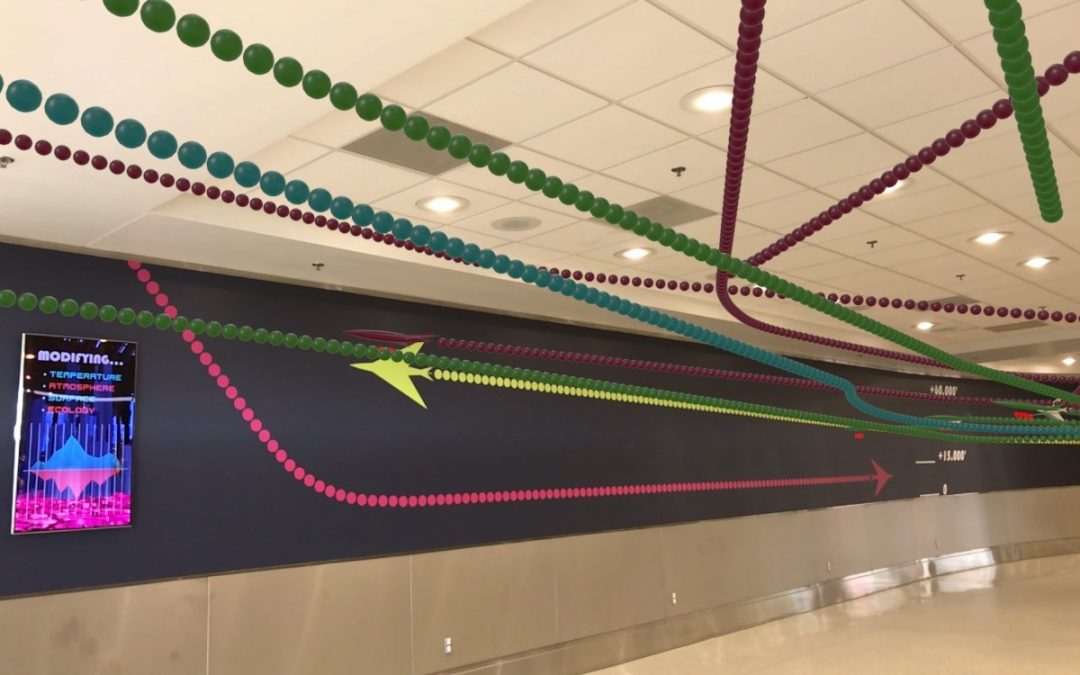The future of airports and the role technology will play in what that will look like are compelling topics in the industry right now. While many are focused on the near future and what it may hold, Miami International Airport’s (MIA) new IM/Movable Assets augmented reality (AR) exhibit examines the airport landscape 500 years from now.
Felice Grodin, the Miami-based artist who created the work in collaboration with the airport and Pérez Art Museum Miami (PAMM), debuted her project in the terminal where it resides near gate D31, on December 19, demonstrating the use of the AR technology using an iPad. Using the PAMM mobile app, Grodin was able to view the terminal through the device’s camera, with some interesting additions to the real world.
“When you mention the passenger’s experience, what’s interesting is the experience of this exhibition focuses on passengers, but also people involved with the airport itself,” said Grodin at the event. “So, it’s to simulate the hypothetical future situation of what it might be like, not just for passengers, but how the airport might evolve.
“Mainly for two reasons,” she added. “One, technology, but also two, climate change. An airport is what they call an immovable asset, you can’t really move an airport, so as sea levels rise, how might the airport have to be reevaluated, and specifically this airport?”
The immersive experience uses smartphone technology to engage airport visitors and encourage participation. Guests need only scan the QR code printed on the floor in front of the exhibit after downloading the PAMM app to unlock Grodin’s idea of the distant future of MIA. Three-dimensional renderings of multiple flight paths are overlaid onto the camera’s view of the real-life terminal. Additionally, below the flight paths, a potential layout of the MIA terminal is visible.
“We’re using augmented reality as a way to stimulate conversation, and so, in this case, there are two levels to the experience. One is above, one is below,” says Grodin. “Essentially, passengers can experience the future of flight radar above, walking through this hypothetical radar, but also below: what will the airport look like? Right now, there are major garages, so obviously there’s a lot of attention on cars. But as the sea level rises and we have to think about possibly terraforming land, maybe it isn’t about the car anymore, maybe it’s more about underground transit or a collective understanding of how to deal with the new ground reality. So, technology is used here, not to solve a problem, but to ask questions.”
In addition to the AR experience available via Apple smart devices, a video created in collaboration with another local artist, AdrienneRose Gionta, is available for viewing. The video portrays the future passenger experience at MIA, depicting a futuristic terminal with flight, time and weather updates, ostensibly appearing in real-time.
“IM/Movable Assets is an exhibition at the intersection of arts, technology and architecture,” said Gendry Sherer, MIA’s director of fine arts and cultural affairs, at the presentation. “In this exhibit, Felice uses augmented reality to imagine the future and figure out what the experience might be like 500 years post-climate change. IM/Movable Assets is an immersive, site-specific, speculative work that virtually interacts with the airport environment and alters the way in which we perceive our surroundings and hypothesize on the future of travel.”
The exhibit will run through the end of February, and is always available for travelers to explore, as it requires only their own mobile devices or the iPad provided by the airport.






